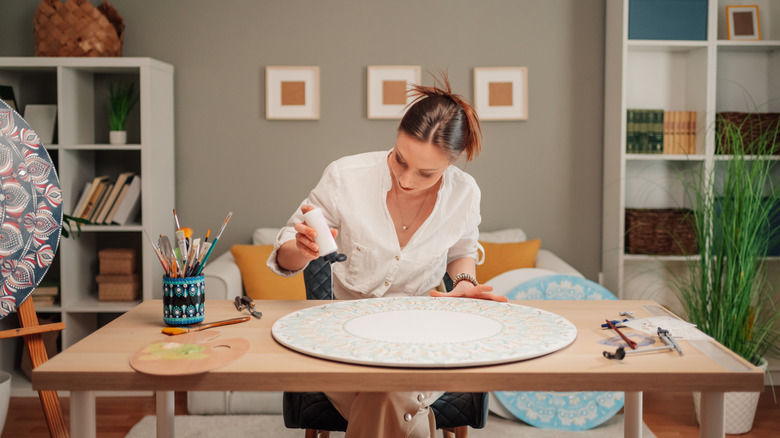Don't Throw Out Old Disks, Use Them To Make Beautiful Mosaics Instead
We may receive a commission on purchases made from links.
While tons of nostalgic items are making comebacks, from '90s kitchen decor trends coming back in style to countless clothing resurgences, we don't blame you if you don't want to bring back CDs. Considering that music has been digitalized to have every song you could imagine available with the press of a button (and maybe a $10 monthly subscription fee), there's not a whole lot of need for the good old circular CDs of yore. And, when people want to listen to music in a nostalgic way, they often jump for record players, since vinyl collections are often fun to display and organize. So, as you shed your old CDs, you can save them from piling up in the trash by creating a beautiful mosaic pattern with the inner layer of each disc.
There are a few different layers that compose a typical CD: the main body is a clear polycarbonate plastic, onto which the data is etched in. There is then a reflective aluminum layer which reflects the data from the plastic part, which is how a laser is able to read the data off of the disc. That aluminum layer is what makes the discs so shiny and perfect for DIY crafts. Finally, the entire thing is protected with a third protective layer, made from acrylic.
How to make a CD mosaic decorative piece
It's important to know the different layers of your CDs because you'll be peeling some away in order to bring this craft to life. By peeling off the plastic layer that stores all the data on the bottom of the disc, you can allow the aluminum reflective layer to really shine, making for the perfect reflective pieces for a disco ball-esque mosaic. As @imac00lmom showed in her TikTok video of this hack, it'll be easier to peel the plastic off once you've cut a large slit into part of the CD, as the layers will naturally start peeling apart. Start by doing this to however many CDs you're wanting to repurpose, and then cut the leftover aluminum layers into smaller pieces, being sure to switch up the shapes and sizes you're cutting so that the mosaic looks more dynamic.
Once you have your aluminum pieces, you'll need to get a surface for your mosaic. You can make an artsy DIY mosaic table, create a chic piece of art for your walls, or even find a styrofoam ball to create your own disco ball. Use superglue to adhere the CD pieces to your selected surface and wait for them to dry. Then, seal the project so that the sharp aluminum edges aren't exposed (this step may not be necessary if you plan to display your craft somewhere where it isn't touched.) You can use a glossy epoxy like Parks Super Glaze Epoxy Ultra Gloss.
Pitfalls to avoid
This craft requires working with materials and supplies that could cause safety concerns, so you should prepare to keep yourself and your surroundings safe with some precautionary measures. For starters, consider using thick gloves when handling the sharp pieces of aluminum from the inside of a CD. Or, at the very least, take the craft slowly and make sure that you're storing the pieces out of reach from pets and children when you aren't around. When it's time to seal your project, take note that epoxy resin can potentially be hazardous, especially when it's in its liquid form. Make sure your craft room has adequate ventilation, or take the project outside to be safe, so you avoid breathing in too many fumes. Consider wearing a mask, gloves, and long sleeves when interacting with the substance, so that it doesn't touch your skin.
Another potential issue is more about aesthetic than safety: It's key to select the right surface for your project so that the end result looks the way you want it to. Because of the nature of making your own mosaic, it's likely that your pieces won't touch and there will be some space between each piece. Unless you want to avoid this by cutting pieces that fit perfectly together (which, though tedious, might be a good idea for a disco ball), you should select a surface that you're okay seeing peek through between pieces. You can paint or stain the surface if you don't like how it looks next to your CD slices.

